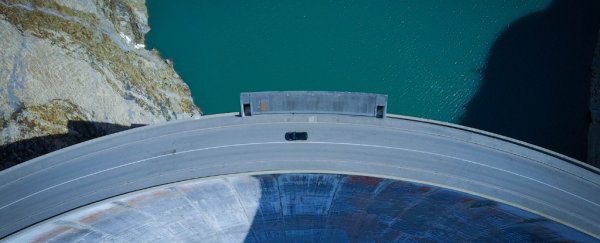If all the hydro-power dams in the United States were removed and replaced with solar panels, it would take up a fraction of the land and produce substantially more electricity, according to a new analysis.
The idea is ambitious, and for now, it's really just a thought experiment. Today, hydropower is a significant source of renewable energy in the US, accounting for roughly six percent of the country's total electricity output.
Removing all 2,603 hydro dams in America would leave a huge energy void behind, but it could also provide room for greener opportunities.
While it's true that hydropower dams are a renewable source of energy, they still produce large amounts of greenhouse gases and can be environmentally destructive and costly to maintain in the long term.
In recent years, these criticisms have led to a growing dam removal movement. And although it's theoretical, a massive investment in solar power might be able to cushion that loss.
To cover for all the hydro dams currently in use, scientists estimate we would need nearly 530,000 hectares of photovoltaics (PV). While this sounds like a lot, it's a "surprisingly modest" amount compared to the combined size of most reservoirs, which cover nearly 4 million hectares nationwide.
In fact, the new analysis suggests that substitute solar panels could match the total energy output from hydro dams while using just 13 percent of the same land.
"I think that's pretty astonishing and tantalising too," John Waldman, an aquatic conservation biologist from the City University of New York, told Carbon Brief.
"I'm hoping this presents a different mindset for people who think about our energy futures."
The potential land sitting under reservoirs right now is immense, and if only 50 percent of that surface is drained and used for solar panels, it could greatly improve energy efficiency, producing nearly three-and-a-half times the amount of energy hydropower currently generates.
Even in a more conservative hypothetical, where only a quarter of that drained land is used for solar farms, Waldman and his colleagues calculate energy production could increase 1.7 fold.
In some states, this has the potential to free up huge swathes of land for other purposes, including wildlife habitat, recreation, and agriculture. In Florida, for instance, scientists calculated a solar farm the size of New York's Central Park (341 hectares) could replace 26,520 hectares of the state's hydro dams.
The new analysis focused on solar power because it is easily scalable, but the authors argue the same logic can also be applied to wind power on a reservoir's surrounding ridges and hydrokinetic turbines in a newly-flowing river.
"Also, potentially expensive and difficult-to-permit electrical lines that transmitted the hydropower already exist at these locations and could potentially be repurposed to carry electricity from alternative sources," the authors argue.
Using existing infrastructure, Waldman ultimately hopes to create an "energy park" in these reservoirs that he says will be "more resilient and more productive than hydropower alone".
The cost of this major transition is not evaluated in the new analysis, and in all likelihood the price would fluctuate quite dramatically depending on the particular hydropower site.
But there's also a cost to hydropower that is rarely considered, especially in the developing world where the technology is taking off. Hydro dams can not only disrupt river ecology, they can also lead to deforestation, a loss of biodiversity, substantial emissions, the displacement of thousands of people, and harms to nearby food and water quality.
Of course, dam removal also needs to be assessed in terms of potential damage to the local ecosystem or even unanticipated downstream impacts, although generally the effect of river restoration has been positive.
The authors of the new analysis admit that their calculations are not exactly "realistic" and their hypothetical is more about potential than anything else. Nowadays, we still can't figure out how to efficiently store and deploy vast amounts of solar power when we need it, so battery storage would need to improve for this idea to come to fruition.
Nevertheless, solar technology is moving quick and Waldman and his colleagues see this as an important avenue to explore in the coming years. So far, most of the dams that have closed down in the US do not produce electricity, and in many ways, that's because we don't have another alternative.
"Today, recognition of decades of unsuccessful restorations predicated on engineered fishways, the rapid ageing of our dams and the inevitable need for their removal for safety reasons in the years ahead, and the advent of other, increasingly cost-effective forms of alternative energy all suggest that there is a way to both reopen our rivers and to replace the energy production they so long provided," Waldman argues in an accompanying editorial.
If solar technology can meet the demands of the 21st century, it could provide considerable environmental and ecological benefits, especially when compared to hydropower. Even better, it has the potential to do this without sacrificing our current energy output.
"The thought experiment proposed by Waldman and colleagues is provocative and contributes to outside-the-box thinking about how society can address pressing issues surrounding freshwater sustainability and energy use," writes political scientist Jeffrey Dudas in a review of the study.
"However, the next steps will be immensely more complex and require additional, more nuanced analyses and technological innovation to help strike the right balance."
Waldman's hypothetical may be extreme, but so are the times we live in.
The findings were published in Nature Sustainability.
